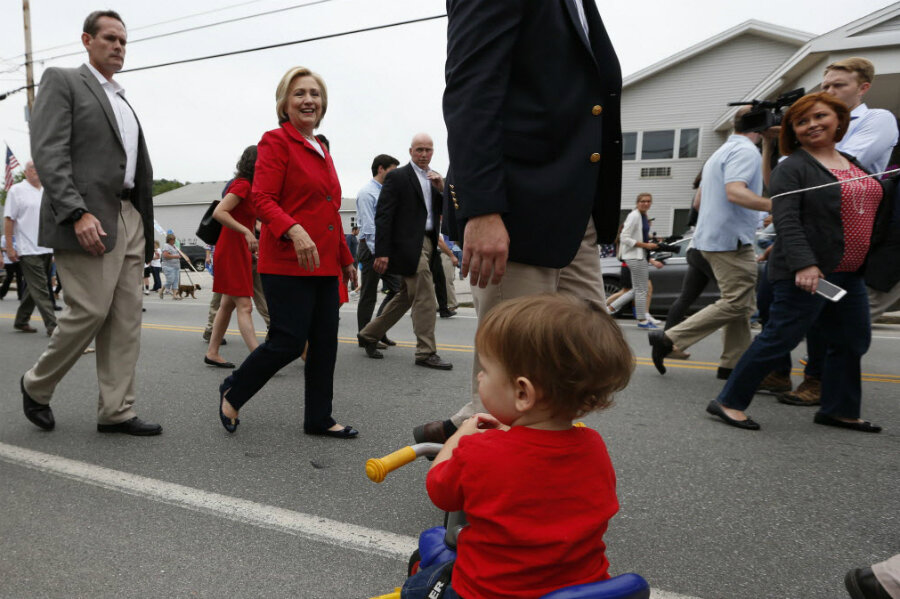Hillary Clinton vs. media: what's really going on
Loading...
| Washington
By now, pretty much everyone has seen the footage of Hillary Clinton marching in a July 4 parade in New Hampshire, with news reporters penned inside a moving “rope line” as they tried to cover her.
This was bad optics – mostly for former Secretary Clinton, but there’s an argument to be made that the press also looked bad for going along. Still, it’s Clinton who has faced the brunt of pundits’ wrath for (once again) being inaccessible to the media, and for making herself – and reporters – look foolish.
Why does the longstanding friction between Clinton and the media persist, and what can be done to serve everyone’s interests – Clinton’s, the media’s, and voters’?
Part of the issue is that, among all the candidates running for president, Clinton is unique – and that affects how her campaign operates.
“Our imperative in our campaign is just different than it is for other candidates,” Jennifer Palmieri, the Clinton campaign’s communications director, said Monday on MSNBC’s “Morning Joe.”
Ms. Palmieri didn’t elaborate, but it’s clear what she meant: As a former first lady, former senator, former presidential candidate, and former secretary of State, Clinton is universally known. Unlike the other candidates, she doesn’t need to boost her name recognition. But she does need to reintroduce herself to voters, and build a sense of connection with them.
Media interest in her is as intense as ever, which creates logistical challenges. And she remains leery of the press – some observers use stronger language – but the reality is that the media’s relationship with the Clinton campaign is better than it was when she ran for president the first time, eight years ago.
“Last time we were in open warfare,” says Mo Elleithee, senior spokesman for Clinton’s 2008 campaign and now executive director of the Georgetown Institute of Politics and Public Service. “From the get-go, it was assumed [by the campaign] that every interaction with the press was going to be hostile. There was a significant amount of stonewalling, and yelling, and just us-vs.-them mentality. That eventually changed, but by then it was too late. The well had been poisoned.”
This time, going in, there’s been more willingness on both sides – the campaign and the media covering it – to work toward a functional modus operandi. For example, the Clinton campaign approached the White House Correspondents’ Association about helping to set up a press pool, similar to the rotation of reporters that covers the president each day. A Clinton press pool has been functioning almost since she announced her campaign.
Clinton campaign press relations aren’t perfect. But they’re more collegial than they were eight years ago, say both campaign operatives and reporters.
Still, reporters need to understand that they can’t have everything they want, Palmieri suggests.
“[The] press is important, but they’re not as important as voters,” Palmieri said on “Morning Joe.”
There’s another reality that the press needs to acknowledge, political strategists note: The media landscape has changed dramatically since 2008, with the advent of Twitter and other social media.
Social media can cut both ways. A campaign – or the White House – can bypass traditional media and reach voters directly on multiple platforms. But a vehicle like Twitter can also just as easily create bad optics for a campaign in a way that didn't happen before social media existed. In 2000, when Clinton ran for Senate, and 2008, when she last ran for president, her campaign used rope to corral reporters, but it wasn't a big story.
Last Saturday, moments after the Clinton campaign deployed its “moving rope line,” at a parade in Gorham, N.H., reporters were tweeting out images.
This and other images of the rope line went viral, creating a social media sensation. The bad news for Team Clinton was that it fit the long-running narrative of tense relations between campaign and press. Reporters amplified the spectacle with accusing tweets.
Republicans also jumped on the bandwagon. The New Hampshire Republican Party slammed “the use of a rope line to protect the arrogant Democrat frontrunner on a public street.”
On the Sunday talk shows, commentators also had fun with the rope line – and took shots at both Clinton and the press.
“This is humiliating for reporters who have to abide by Hillary Clinton’s rules of journalism,” said S.E. Cupp on CNN’s "State of the Union."
And, Ms. Cupp added, “actually I don’t blame her, I blame reporters who put up with this. The second they decide we’re not doing this anymore, we’re not going to cover your glossy events the way you want it, then she’ll be forced to change this behavior.”
As for Clinton’s media strategy, Palmieri acknowledged Monday that the campaign takes its lumps for not giving the press what it wants, but suggested a larger goal – to build a “good foundation” for a campaign she hopes will take Clinton all the way to the White House.
“I understand ... that we pay a price with the press when we don’t do interviews, and when we do smaller events that don’t have the access that a larger event may allow,” Palmieri said on “Morning Joe.” “But this is part of our calculus about how we’re building a campaign that’s built to last. And she learned a lot of lessons in 2008.”
As it happens, the Clinton campaign is now moving into a new phase of greater accessibility to the media. On Tuesday, Clinton will give her first national TV interview since announcing her campaign to CNN.






